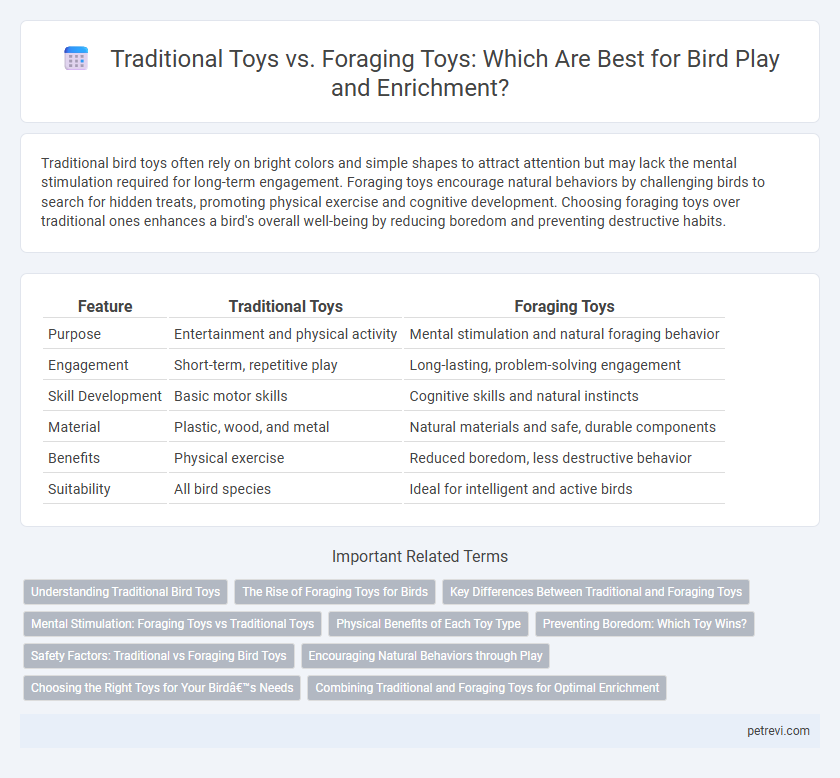Traditional bird toys often rely on bright colors and simple shapes to attract attention but may lack the mental stimulation required for long-term engagement. Foraging toys encourage natural behaviors by challenging birds to search for hidden treats, promoting physical exercise and cognitive development. Choosing foraging toys over traditional ones enhances a bird's overall well-being by reducing boredom and preventing destructive habits.
Table of Comparison
| Feature | Traditional Toys | Foraging Toys |
|---|---|---|
| Purpose | Entertainment and physical activity | Mental stimulation and natural foraging behavior |
| Engagement | Short-term, repetitive play | Long-lasting, problem-solving engagement |
| Skill Development | Basic motor skills | Cognitive skills and natural instincts |
| Material | Plastic, wood, and metal | Natural materials and safe, durable components |
| Benefits | Physical exercise | Reduced boredom, less destructive behavior |
| Suitability | All bird species | Ideal for intelligent and active birds |
Understanding Traditional Bird Toys
Traditional bird toys often consist of simple materials like wood, rope, and bells, designed primarily for entertainment and basic physical activity. These toys encourage chewing and climbing but lack the complexity needed to stimulate a bird's cognitive skills and natural foraging behaviors. Understanding the limitations of traditional toys highlights the importance of incorporating foraging toys, which engage a bird's problem-solving abilities and mimic natural food-searching activities.
The Rise of Foraging Toys for Birds
Foraging toys for birds have gained popularity as they stimulate natural behaviors like searching for food, enhancing mental and physical health compared to traditional toys that primarily offer passive engagement. These interactive toys improve problem-solving skills and reduce boredom-related stress by encouraging exploration and activity. The rise of foraging toys reflects an increased understanding of avian enrichment needs, promoting overall well-being in pet birds.
Key Differences Between Traditional and Foraging Toys
Traditional bird toys primarily focus on visual appeal and simple interaction, often designed with bright colors and basic shapes to attract attention. Foraging toys encourage natural behaviors by requiring birds to work for their food or treats, promoting mental stimulation and physical activity. The key difference lies in engagement; traditional toys offer passive play, whereas foraging toys provide interactive challenges that support cognitive development and prevent boredom.
Mental Stimulation: Foraging Toys vs Traditional Toys
Foraging toys provide enhanced mental stimulation for birds by encouraging natural behaviors such as problem-solving and searching for hidden treats, which traditional toys often lack. These interactive toys challenge cognitive skills and prevent boredom, promoting overall well-being and reducing negative behaviors like feather plucking. In contrast, traditional toys tend to focus more on physical activity without engaging the bird's intellect to the same extent.
Physical Benefits of Each Toy Type
Traditional bird toys such as swings and ladders enhance gross motor skills by encouraging climbing and balancing, promoting muscle strength and coordination. Foraging toys stimulate natural behaviors, requiring birds to manipulate objects and solve puzzles, which improves fine motor skills and mental agility. Both toy types contribute to overall physical fitness, reducing obesity risk and supporting healthy bone development in pet birds.
Preventing Boredom: Which Toy Wins?
Traditional toys such as bells, mirrors, and ladders offer simple entertainment but can quickly lose a bird's interest, increasing the risk of boredom-driven behaviors like feather plucking. Foraging toys engage birds mentally and physically by simulating natural food-searching behaviors, promoting healthy cognitive stimulation and reducing stress. Studies show that foraging toys consistently outperform traditional toys in preventing boredom, enhancing overall bird welfare and activity levels.
Safety Factors: Traditional vs Foraging Bird Toys
Traditional bird toys often pose safety risks due to small parts, toxic paint, and easily frayed materials that can cause choking or ingestion hazards. Foraging toys are designed with non-toxic, durable materials and minimize detachable pieces, enhancing safety by encouraging natural behaviors without exposure to harmful substances. Prioritizing toys with safe construction and appropriate size ensures birds remain injury-free during play and mental stimulation.
Encouraging Natural Behaviors through Play
Foraging toys stimulate birds' instinctual behaviors by encouraging exploration and problem-solving, closely mimicking their natural feeding activities. Traditional toys, while entertaining, often lack the complexity needed to engage birds' cognitive skills and foraging instincts. Integrating foraging toys into play routines supports mental health and reduces boredom by promoting natural behaviors essential for avian well-being.
Choosing the Right Toys for Your Bird’s Needs
Traditional bird toys, often made from wood, rope, and plastic, provide basic entertainment but may lack mental stimulation necessary for a bird's cognitive health. Foraging toys encourage natural behaviors by challenging birds to search for hidden treats, promoting mental engagement and physical activity. Selecting toys based on species-specific needs, such as puzzle complexity and material safety, enhances enrichment and prevents boredom-related behaviors in parrots and other pet birds.
Combining Traditional and Foraging Toys for Optimal Enrichment
Combining traditional toys, such as bells and mirrors, with foraging toys that encourage natural behaviors like searching and problem-solving, enhances a bird's mental stimulation and emotional well-being. Integrating these types of toys promotes physical activity and reduces boredom, leading to improved cognitive function and decreased stress levels in pet birds. Optimal enrichment through varied toy types supports overall health and prevents behavioral issues like feather plucking and aggression.
Traditional toys vs Foraging toys for Bird play Infographic

 petrevi.com
petrevi.com